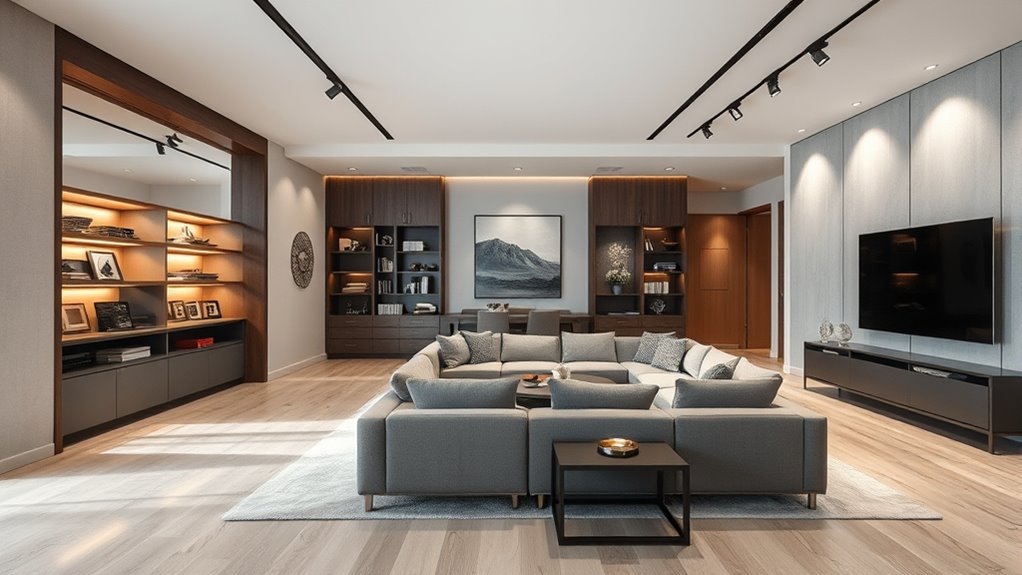Interior designers use clever tricks like precise measurement, detailed floor plans, and balanced proportions to create harmony. They layer textures, extend window treatments, and strategically place furniture to enhance room height and flow. Smart furniture arrangements and grounding elements help balance visual weight, while versatile pieces boost flexibility. Incorporating open layouts and adaptable features allows your space to evolve with your lifestyle. Keep exploring these techniques to transform your home into a stylish, functional haven.
Key Takeaways
- Utilize the golden ratio and proper scale to create balanced, harmonious furniture and artwork arrangements.
- Layer textures, patterns, and window treatments to add depth and visual interest, emphasizing verticality and focal points.
- Hang curtains close to the ceiling with floor-to-ceiling drapes to visually heighten and expand space.
- Incorporate multi-functional and movable furniture to maximize flexibility and optimize room layout.
- Use strategic lighting, color schemes, and focal points to guide the eye and enhance perceived room size.
Precise Measuring and Creating Detailed Floor Plans
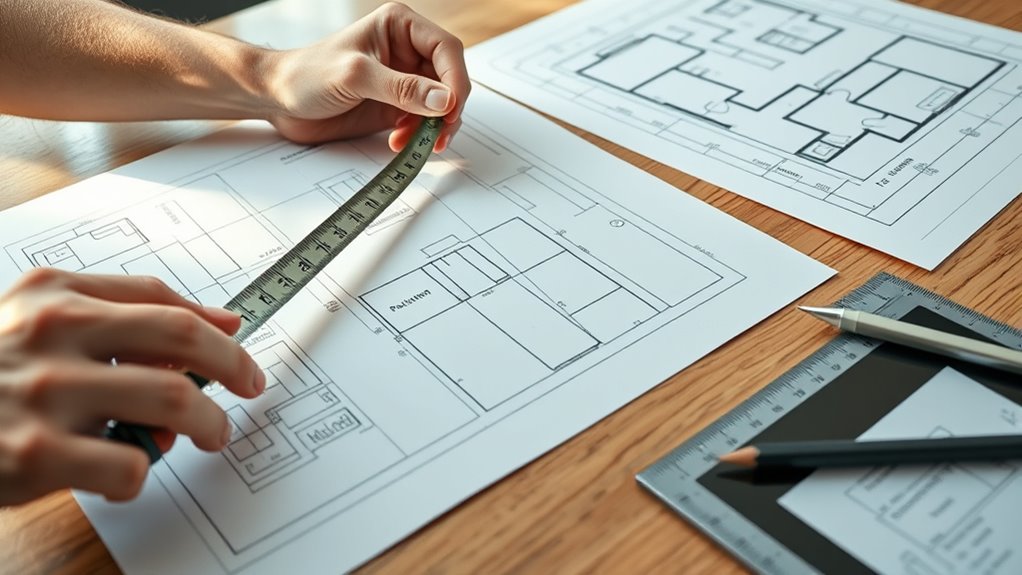
To guarantee your interior design layout is accurate and functional, start by measuring your space carefully. Accurate measurements are essential for creating a precise floor plan that reflects your room’s true dimensions. Use a laser measure or tape to take multiple readings of each area, including length, width, and ceiling height. Document all fixed elements like windows, doors, outlets, and built-ins to prevent layout errors and maximize space utilization. Drawing your floor plan to scale on graph paper or using digital software like SketchUp ensures precise visualization. Consistently use the same measurement method and double-check your dimensions. Paying attention to speeds and measurements is crucial when planning for furniture placement and room accessibility, especially in spaces where equipment or heavy fixtures are involved. Incorporating Self Watering Plant Pots concepts such as reservoir systems and capillary action can inspire a methodical approach to layout planning, ensuring everything fits perfectly. Additionally, understanding lifestyle factors, such as daily habits and ergonomic needs, helps in designing spaces that are both beautiful and practical. This attention to detail helps ensure furniture fits perfectly and room proportions stay balanced, setting a solid foundation for your interior design project.
Utilizing Scale and Proportion for Balance

Achieving visual harmony in your interior space hinges on understanding and applying proper scale and proportion. When selecting furniture and accessories, keep in mind these key principles:
Creating harmony in your interior design depends on understanding scale and proportion.
- Use a scale where ceiling heights are 1.5 to 2 times the height of your sofa for balanced proportions. Incorporating natural materials like wood and stone can further enhance the authentic farmhouse feel and contribute to the overall balance. Additionally, paying attention to craftsmanship ensures that each piece complements the space with quality and durability. Recognizing design principles helps create a cohesive aesthetic that resonates throughout the room.
- Apply the golden ratio (about 1:1.618) to size artwork and furniture, creating pleasing relationships.
- Choose furniture that fits your room’s dimensions—avoid oversized pieces that dominate or undersized items that seem out of place.
- Test different proportions with scale models or layouts before finalizing your design.
- Incorporate properly scaled planters to enhance visual balance and complement your furniture arrangement.
- Remember that attention to detail in proportion helps develop a cohesive and inviting environment.
Adjusting the size of rugs, curtains, and accessories relative to your furniture guarantees a seamless flow. Mastering scale and proportion brings the perfect balance and visual harmony to your interior design.
Layering Textures for Visual and Tactile Interest
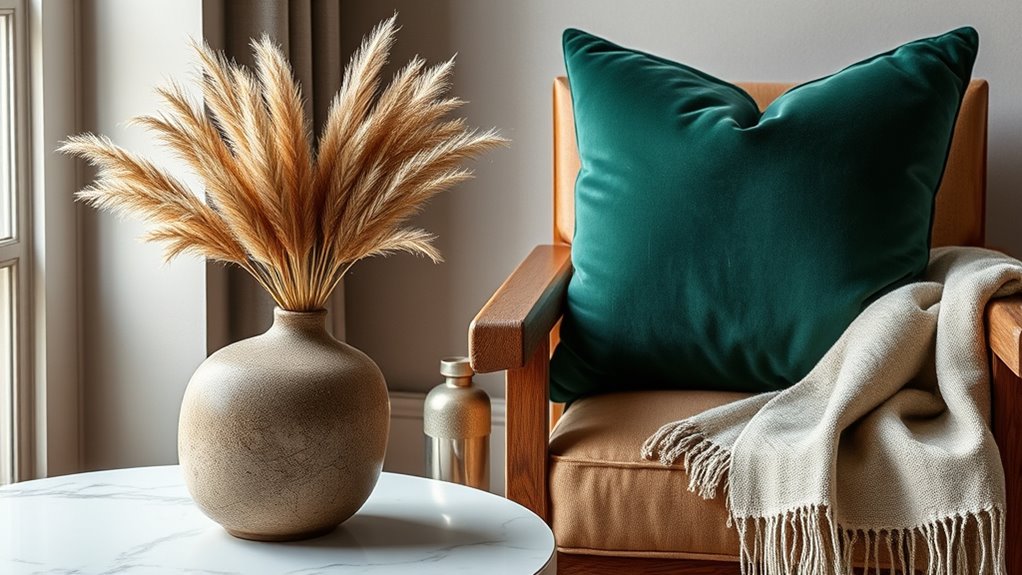
Layering textures transforms a flat, monotonous space into a dynamic and inviting environment. By layering textures like velvet, linen, and wool, you add depth and visual interest that make the room feel rich and cozy. Incorporate natural materials such as wood, stone, and rattan to introduce tactile variety and enhance the sensory experience. Textured accessories like embroidered pillows, woven baskets, and textured rugs break up flat surfaces, adding dimension and intrigue. Strategic placement of these textured elements helps balance bold patterns and vibrant colors, preventing visual overload and creating harmony. Combining different textures in a layered way elevates your room’s design, making it appear thoughtfully curated and more physically engaging.
Extending Window Treatments to Enhance Height
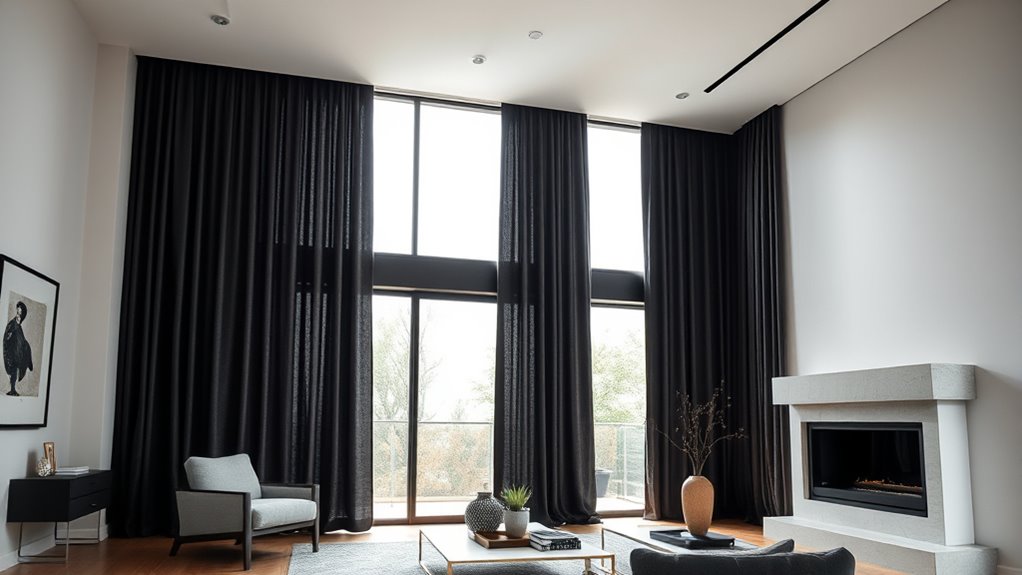
Extending your window treatments beyond the frame creates the illusion of taller ceilings and makes your room feel more spacious. Mounting curtains closer to the ceiling enhances verticality and draws the eye upward. Choosing floor-to-ceiling drapes with lightweight fabrics boosts height while adding a luxurious touch. For added convenience, many stores offer online shopping options, making it easier to find the perfect window treatments outside of regular hours. Incorporating seasonal variations in your window treatments can also keep your space feeling fresh and dynamic throughout the year. Additionally, understanding interior design principles can help you select the most effective treatment styles for your space. Implementing the right measurement techniques ensures a perfect fit and a polished appearance. Applying proper installation methods can further improve the overall aesthetic and functionality of your window treatments.
Larger Illusions of Space
By extending your window treatments beyond the frame by 8 to 10 inches, you can create the illusion of taller ceilings and larger windows. This simple trick enhances the perception of space and makes your room feel more open. To maximize this effect, consider:
- Hanging curtains close to the ceiling instead of at the window frame to emphasize height.
- Using floor-to-ceiling drapes that add vertical lines, making ceilings appear higher.
- Selecting lightweight, sheer fabrics to let in more natural light, brightening the space.
- Incorporating vertical patterns or stripes in your window treatments and wall coverings to visually elongate the room.
- Planning your interior design approach with effective preparation to ensure your window treatment choices align with your overall space goals.
- Choosing appropriate window treatment materials that reflect your room’s style and enhance the illusion of height.
These techniques work together to create larger illusions of space, transforming your room into a more expansive, airy environment.
Enhanced Room Height
When you mount your curtain rods close to the ceiling instead of at the window’s top, you instantly add visual height to the room. This simple change enhances interior design by creating the illusion of taller ceilings and more space. Extending window treatments beyond the frame emphasizes vertical lines, making your room feel grander. Long, flowing drapes from ceiling to floor draw the eye upward, optimizing space and height. Layered window treatments, like sheers behind heavier drapes, add depth and further highlight room height. Narrow, elongated treatments reduce clutter, accentuating the vertical space. Visualize it with this layout:
| Window Treatment Style | Effect on Room Height |
|---|---|
| Ceiling-mounted rods | Creates height illusion |
| Floor-to-ceiling drapes | Enhances vertical lines |
| Layered treatments | Adds depth and dimension |
| Narrow treatments | Minimizes clutter, emphasizes height |
| Long fabrics | Draws eyes upward |
Adding proper lighting can also enhance the perception of height and space in a room. Incorporating appropriate color schemes, such as light or neutral tones, can further amplify this effect. Using light-colored fabrics can reflect more light, further emphasizing the height. Additionally, choosing quality fabric materials ensures the treatments hang smoothly and create a polished look, contributing to the overall sense of spaciousness.
Balancing Visual Weight With Strategic Furniture Placement

To create a balanced and harmonious space, strategic furniture placement plays a essential role in managing visual weight. You want to distribute larger furniture pieces evenly, so no area feels too heavy or cluttered. Imagine:
- Placing a sizable sofa centrally, anchored by side tables or lamps to guide the eye.
- Positioning tall bookshelves or cabinets opposite or near focal points to create symmetry.
- Mixing tall, short, and medium-height pieces to add visual interest and prevent monotony.
- Clustering smaller accent pieces and accessories around larger furniture to layer and balance the overall visual weight.
Using Focal Points to Anchor the Layout
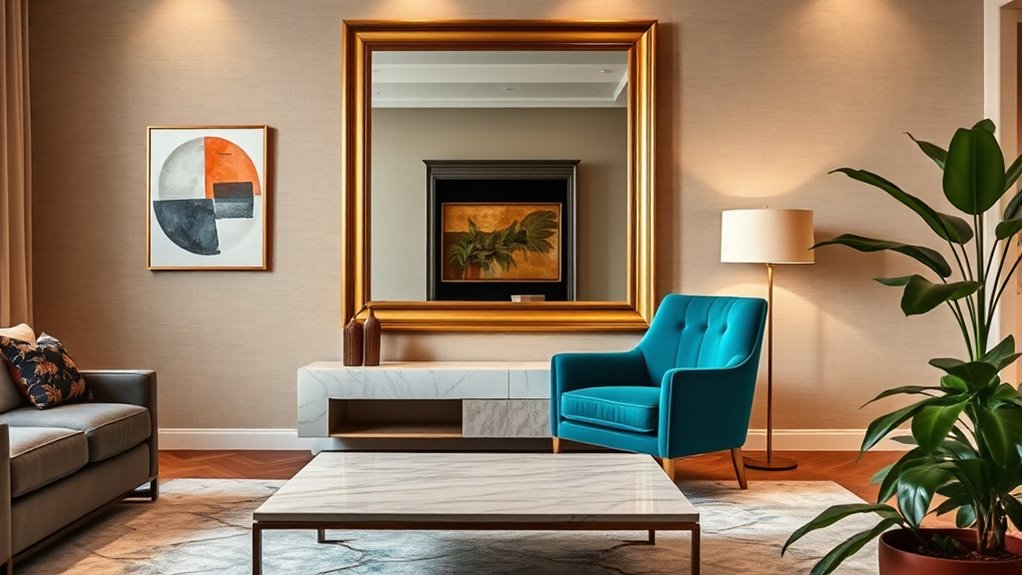
To create a cohesive room, focus on emphasizing natural focal elements like a fireplace or large window. Framing these features with architectural details or bold decor draws attention and grounds the layout. Using eye-catching accessories helps guide the eye and establishes a strong visual anchor for the space.
Emphasize Natural Focal Elements
Identifying a natural focal point, such as a fireplace or large window, helps you anchor the room’s layout and create visual balance. Once you’ve chosen your focal point, emphasize it to draw attention and enhance its role. Consider these steps:
- Position key furniture, like sofas or chairs, facing or surrounding the focal point.
- Use contrasting or complementary colors and textures near the focal element to make it stand out.
- Add artwork, statement lighting, or architectural features directly at or around the focal point.
- Arrange functional areas to naturally face or highlight this feature, ensuring it becomes the visual anchor of your space.
Frame With Architectural Features
Have you considered how architectural features can serve as natural framing devices to organize and define your space? Focal points like fireplaces, built-in bookshelves, or statement windows create visual anchors that guide your room’s layout. Framing with archways or coffered ceilings establishes boundaries, helping you position furniture for ideal flow and balance. By placing key pieces near these architectural focal points, you emphasize their importance and create harmony in the space. These features also help define zones within open-plan areas, boosting both functionality and aesthetic coherence. Incorporating accent walls or niche lighting around focal points further draws attention and reinforces the room’s structure. Using architectural elements as visual anchors transforms your space into a well-organized, inviting environment.
Use Eye-Catching Decor
Ever wondered how a single piece of eye-catching decor can transform the entire layout of a room? That’s the power of a well-placed focal point. By choosing something bold—like a vibrant rug, a striking piece of art, or a unique chandelier—you create an anchor that guides the eye and defines the space. Imagine:
- A large, colorful painting that draws attention to one wall
- An eye-catching pendant light that becomes the room’s centerpiece
- A statement sculpture that naturally attracts focus
- A distinctive area rug that grounds the seating zone
These focal points help shape the layout, making the space feel cohesive and intentional. Strategically placed decor not only beautifies but also directs movement, ensuring your room feels balanced and inviting.
Maximizing Space With Smart Furniture Arrangement
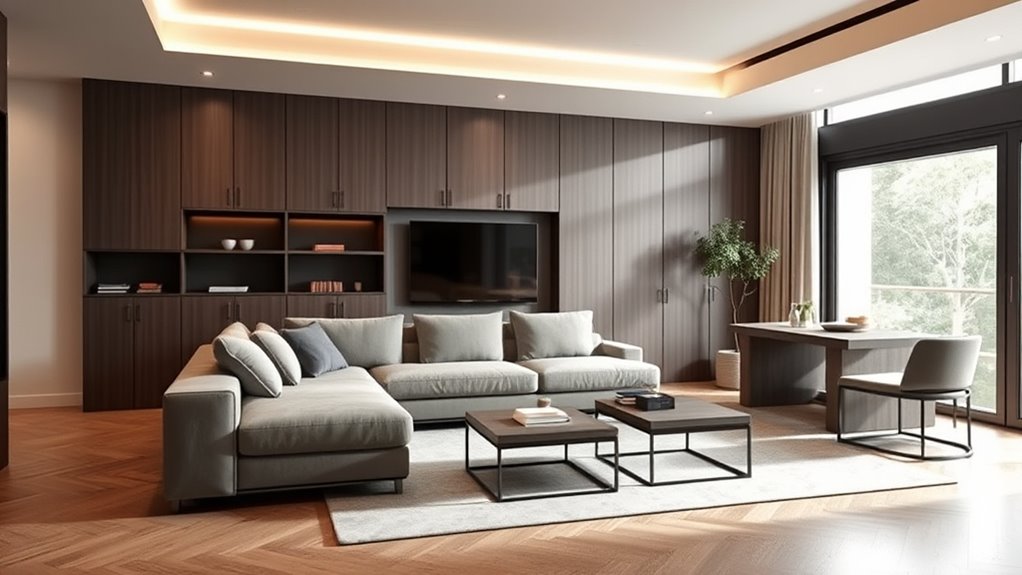
Maximizing space with smart furniture arrangement involves thinking strategically about how you place each piece to enhance both function and flow. With smart furniture arrangement, you can create open pathways that improve movement and make small rooms feel larger. Reconfiguring furniture to establish clear zones and using multi-functional pieces, like storage ottomans or fold-away desks, maximizes utility without clutter. Applying the “rule of three” for grouping helps maintain balanced focal points and avoids overcrowding. Elevating seating and tables on subtle risers defines separate zones within open-plan spaces while keeping the overall harmony. Incorporating floating furniture, such as wall-mounted shelves or sofas, frees up floor space, making your room appear more spacious and inviting. Smart furniture arrangement is the key to transforming cramped areas into functional, airy spaces.
Incorporating Grounding Elements for Visual Calm

Incorporating grounding elements like lamps, rugs, and furniture pieces helps create visual anchors that bring balance to busy patterns and vibrant decor. These grounding elements establish a sense of stability and calmness in your interior design. To enhance visual calm, consider:
- Placing a neutral-toned rug with natural materials like stone or distressed leather beneath your main seating area.
- Adding strategically positioned lamps near focal points to guide the eye smoothly around the room.
- Choosing finishes and colors on accessories that complement wallpaper and textiles for harmony.
- Layering textures and keeping a cohesive color palette in your grounding pieces to foster a soothing environment.
Enhancing Room Flow Through Open and Fluid Layouts
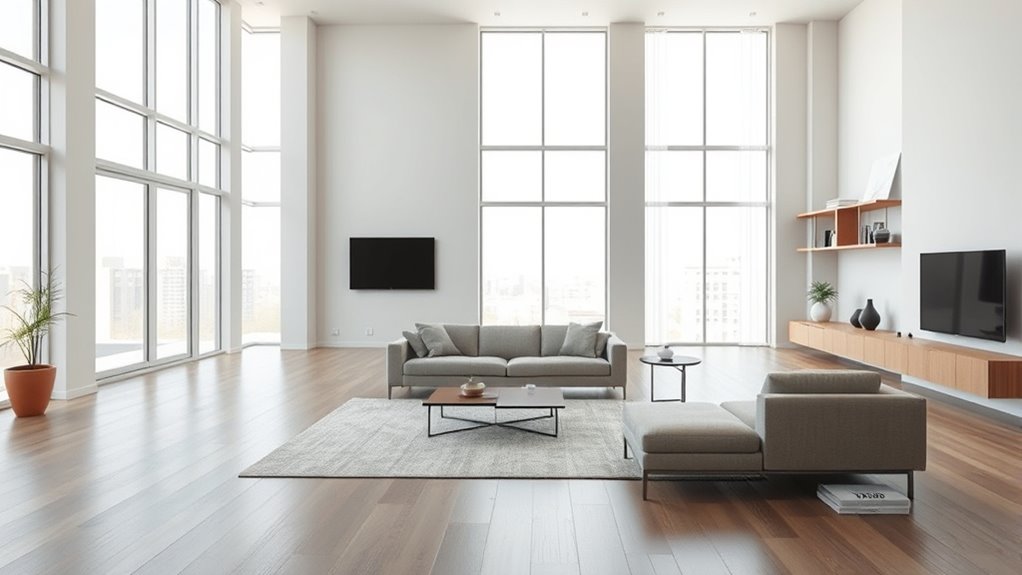
Creating clear pathways and smooth circulation is key to an open, fluid layout. Strategic furniture placement and visual anchors, like rugs or lighting, help define zones without disrupting flow. When you prioritize these elements, your space feels more spacious and inviting.
Clear Pathways and Circulation
To guarantee smooth movement throughout your space, arranging furniture to leave clear, unobstructed pathways is essential. Good space planning ensures circulation remains fluid and traffic flow stays natural. Focus on these interior design tips:
- Create pathways of at least 24-36 inches wide for easy circulation.
- Position key furniture like sofas, tables, and chairs to prevent congestion.
- Use rugs and area mats to define zones while maintaining open pathways.
- Incorporate architectural elements such as open floor plans and strategic door placements to enhance visual continuity and room layout.
Use of Visual Anchors
Using visual anchors effectively can substantially improve the flow and cohesion of an open-concept space. Rugs, artwork, and statement furniture serve as interior design secrets that define zones, guiding your eye from the living room to the dining room. Strategically placing larger pieces near focal points creates natural anchors, making your space feel inviting and cohesive. Maintaining a consistent color palette and materials across zones visually connects different areas, creating a sense of harmony. Incorporating architectural elements like partial dividers or built-in shelving subtly delineates spaces without disrupting the open flow. Positioning furniture to maximize countertop space while creating clear pathways ensures smooth back-and-forth movement. Whether you wanted to find design inspiration for a small space or a larger living space, rest assured these design tips will help you achieve room design with peace of mind.
Planning for Flexibility to Adapt to Lifestyle Needs

Planning for flexibility in your interior layout guarantees your space can easily adapt to changing needs and lifestyles. You are trained on data up to October 2023, so consider these strategies:
- Use multi-functional furniture like sofa beds or storage ottomans to maximize space and versatility.
- Incorporate modular or movable partitions to reconfigure open layouts for privacy or different activities.
- Choose portable, lightweight furniture pieces that can be effortlessly relocated as your routines evolve.
- Install adjustable lighting and flexible window treatments to easily control ambiance and privacy.
Frequently Asked Questions
What Is the 3-5-7 Rule in Decorating?
The 3-5-7 rule in decorating helps you create balanced, attractive groupings of objects, artwork, or furniture. You arrange items in odd numbers—like three, five, or seven—to make your space feel harmonious and natural. This technique keeps things from looking cluttered and adds visual interest. When hanging art or placing accessories, use these groupings to achieve a cohesive, well-thought-out look effortlessly.
What Is the 70 30 Rule in Interior Design?
The 70/30 rule in interior design means you should fill 70% of your space with neutral, calming elements, while the remaining 30% features bold, eye-catching accents. You can achieve this by pairing understated backgrounds with vibrant artwork or textured textiles. It helps you create a balanced, cohesive look that feels both sophisticated and lively, preventing your room from appearing too busy or overwhelming.
What Is the 60 40 Rule in Interior Design?
The 60/40 rule in interior design helps you create a balanced look by dividing your space into two parts. You should use neutral or calming tones for about 60% of the room, like walls or large furniture, and then add bolder colors or patterns for the remaining 40%, such as accent pieces or textiles. This approach keeps your space visually appealing and prevents it from feeling overwhelming or cluttered.
What Are the 7 Basics of Interior Design?
Imagine you’re stepping into a room that feels just right—that’s because of the seven basics of interior design. You focus on scale, making sure furniture fits; proportion, balancing sizes; and balance, creating stability. You also use rhythm and emphasis to guide the eye, while harmony and contrast tie everything together. These principles help you craft a space that’s cohesive, inviting, and perfectly tailored to your style.
Conclusion
By mastering these secret layout tricks, you can transform your space into something truly extraordinary—it’s like turning your home into a sanctuary of style and comfort. Precise measurements, clever furniture placement, and thoughtful details will elevate your design game to new heights. Don’t settle for ordinary when you have the power to create a stunning, balanced, and functional space that feels as perfect as a masterpiece. Your dream home is just a layout away!
